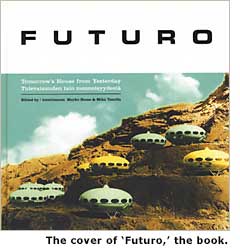Falling for a Futuro - Page 3
The Futuro, buyers were promised, required no maintenance. "Just get out the garden hose and spray it off," Donaldson says. Not so, he adds. You don't need to scrape off barnacles, but in other respects it needs to be treated like a fiberglass boat. "Can you imagine anyone waxing this house?" he asks. "Just getting up on a ladder and not slipping off?"
But the Futuro has never appealed to people who care primarily about housekeeping. For Victoria Clarkin, who's been a Futuro fan since spending her high school graduation weekend in the famous beachside Futuro at Pensacola Beach, Florida, the appeal proved irresistible. "I just knew the spaceship was going to own me one day," she says.

Clarkin owns a Futuro with her husband, Mark, who's been known to dress like an alien. They use it as their beach house. The house has withstood Hurricanes Ivan and Dennis ("It's round and aerodynamic, so when rain and wind hit it, it doesn't get too damaged," Victoria says) and hordes of tourists who beg to get inside. On a busy beach day, Clarkin says, 500 people take a photo of the Futuro. They often place aliens in the windows, and at Christmas, aliens wearing Santa hats.

For one Halloween—"a big mistake," Victoria recalls—the Clarkins informed the local newspaper the house would be open to the public. "We had people coming all the way from Alabama. The line was down the ramp, down the street, and around the block."
Clarkin, who says she is psychic, claims her Futuro, which she nicknamed the 'Spaceship,' is home to a ghost dog. A black cat—named Astro, of course—just can't stay out—even when the Futuro "is locked up tight as a drum!"
"Wayne Donaldson would never agree with any of this," she says. "He's so scientific."
The Clarkins' Futuro sits atop a 1950s-era concrete beach house. Clarkin has turned the Futuro and the house into headquarters for the Pensacola Beach Preservation and Historical Society, and may eventually hold meetings there.
Many fans see the Futuro as nostalgia—a spaceship fit for Barbarella, with smooth, sybaritic curves. The Futuro provides a mid-'60s vision of the future that was already falling out of touch with the zeitgeist by 1968—more Dean Martin and Hugh Hefner than Crosby Stills and Nash—and certainly out of line with the Mothers of Inventions song 'Plastic People.' ("I'm sure that love...will never be... a product of...plasticity").

The Futuro represented an optimistic view of technology as a force that would solve man's problems. Gaining steam, however, was the fear that technology was running amok.
There's nothing about the Futuro that suggests the whole grain, communal, build-your-own-yurt movement. Donaldson himself, a child of the '60s, was also too techno to be a hippie. He recalls camping with a group of friends who called themselves the West Coast Electric Campfire Group, with "everything we could get in the market that you could plug in. We were looking at modern uses, modern materials to solve problems, rather than retreating back into the woods to find an alternate lifestyle."
The first time Donaldson saw his Futuro, it was painted red, white, and blue and was serving as a naval recruiting station in San Diego. A few years later he came upon it again, painted green and slated for demolition. "I said, 'gosh—don't demolish it,'" Donaldson recalls.

By this time his architectural career had switched from designing high-tech structures of plastic to preserving buildings from the past. Besides working as a preservation architect on many historic buildings, as the State Historic Preservation Officer, Donaldson has helped to save many others, and to educate the public about the value of historic buildings.
In fact, it was Donaldson's staff at the state's Office of Historic Preservation that worked closely with the Eichler 'Historic Quest' committee to win spots on the National Register of Historic Places for two Palo Alto Eichler neighborhoods.
Donaldson understood that the Futuro, which once had a brave future, was now something from the 'Past-o.' There are only six Futuros remaining in the United States that Donaldson has been able to locate, and most are in dire shape, he says. He's visited all but one.





